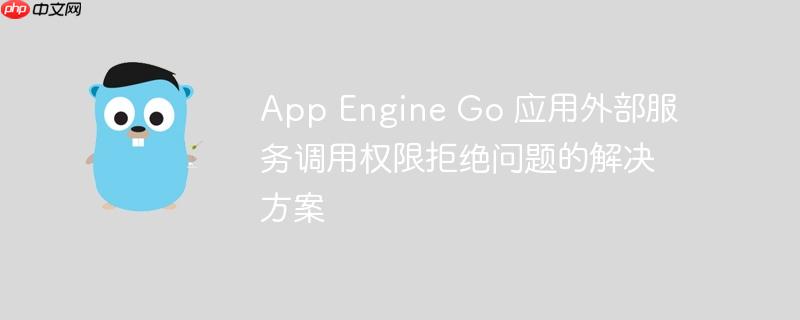
google app engine 的go运行时环境是一个高度沙盒化的平台,旨在提供安全、可扩展和易于管理的应用程序部署。在这种沙盒环境中,应用程序对底层系统资源(包括网络接口)的直接访问受到严格限制。当开发者尝试在app engine go应用中使用go标准库中的net/http客户端(例如client := http.client{})直接发起http请求访问外部服务时,由于缺乏直接进行底层网络操作的权限,通常会遇到“permission denied”错误。
这种权限拒绝是App Engine安全模型的一部分,它确保了应用程序只能通过平台提供的受控API与外部世界交互。因此,为了在App Engine Go应用中成功地进行出站HTTP/HTTPS请求,必须使用App Engine专门提供的URL Fetch服务。
Google App Engine为Go应用提供了一个名为URL Fetch的服务(通过appengine/urlfetch包提供),它是处理所有出站HTTP和HTTPS请求的官方且推荐的机制。URL Fetch服务不仅解决了沙盒环境中的权限问题,还提供了以下额外优势:
要正确地从App Engine Go应用中调用外部服务,核心在于使用appengine/urlfetch包提供的Client。这个客户端实现了Go标准库的http.Client接口,但其底层通过URL Fetch服务代理了所有网络请求。关键在于,urlfetch.Client的初始化需要一个appengine.Context对象,这个上下文对象承载了当前请求的App Engine环境信息。
以下是使用appengine/urlfetch服务的正确实现方式:
package main
import (
"fmt"
"io/ioutil" // 用于读取响应体
"net/http" // 标准HTTP库
"appengine" // App Engine上下文包
"appengine/urlfetch" // URL Fetch服务包
)
// handler 函数处理传入的HTTP请求
func handler(w http.ResponseWriter, r *http.Request) {
// 1. 获取当前请求的App Engine上下文。
// 这是进行任何App Engine服务调用的前提。
c := appengine.NewContext(r)
// 2. 使用App Engine上下文初始化urlfetch客户端。
// 这个client实现了net/http.Client接口,但其底层通过URL Fetch服务代理了所有网络请求。
client := urlfetch.Client(c)
// 3. 构建目标URL。这里使用r.RemoteAddr作为示例IP。
targetURL := "http://api.wipmania.com/" + r.RemoteAddr
c.Infof("Attempting to fetch location data from: %s", targetURL) // 记录日志
// 4. 发起HTTP GET请求。
// client.Get()等操作与标准net/http客户端的使用方式完全一致。
resp, err := client.Get(targetURL)
if err != nil {
// 记录错误并向客户端返回错误信息
c.Errorf("Error getting location from ip: %s", err.Error())
http.Error(w, "Failed to fetch external data: "+err.Error(), http.StatusInternalServerError)
return
}
defer resp.Body.Close() // 确保响应体被关闭,防止资源泄露
// 5. 处理响应。
if resp.StatusCode != http.StatusOK {
c.Errorf("External service returned non-OK status: %d", resp.StatusCode)
http.Error(w, fmt.Sprintf("External service returned status: %d", resp.StatusCode), http.StatusInternalServerError)
return
}
body, err := ioutil.ReadAll(resp.Body)
if err != nil {
c.Errorf("Error reading response body: %s", err.Error())
http.Error(w, "Failed to read external service response", http.StatusInternalServerError)
return
}
// 示例:将外部服务的响应内容写回客户端
w.Header().Set("Content-Type", "text/plain; charset=utf-8")
fmt.Fprintf(w, "External service response (Status: %d):\n%s", resp.StatusCode, string(body))
c.Infof("Successfully fetched external data. Status: %d, Response length: %d", resp.StatusCode, len(body))
}
// 实际应用中,你需要在init函数中注册这个handler
// func init() {
// http.HandleFunc("/", handler)
// }代码解析:
在App Engine Go环境中进行外部HTTP/HTTPS调用时,核心原则是始终使用appengine/urlfetch服务提供的客户端。通过正确初始化和使用urlfetch.Client,开发者可以无缝地集成外部服务,同时确保应用的稳定性、安全性和符合App Engine的运行规范。遵循这些指导原则将有效避免“permission denied”等常见的网络访问错误,使应用能够可靠地与外部世界交互。
以上就是App Engine Go 应用外部服务调用权限拒绝问题的解决方案的详细内容,更多请关注php中文网其它相关文章!

每个人都需要一台速度更快、更稳定的 PC。随着时间的推移,垃圾文件、旧注册表数据和不必要的后台进程会占用资源并降低性能。幸运的是,许多工具可以让 Windows 保持平稳运行。

Copyright 2014-2025 https://www.php.cn/ All Rights Reserved | php.cn | 湘ICP备2023035733号